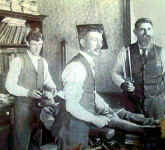
ALEX PECK MEDICAL AND SURGICAL ANTIQUES ARCHIVES
All pictures and text on this site are copyrighted ©1982-2025 Alex Peck. All rights reserved.
PAGE 34
________________________________
An original c. 1890s albumen photograph of an amputation of a gangrene foot. The figures are identified as Drs. Walker, [Samuel] Burnsides (1855-1918; University of Pennsylvania, 1882), and [Liewellyn] Coons (1847-1921; Louisville School of Medicine, 1867). The setting is Dr. Coons' office in Wichita Falls, Texas, and an adolescent male patient is on an fully-opened operating chair. He is being administered anesthesia by Dr. Walker, on the left, and a French style tourniquet has been placed around the right leg. Dr. Burnsides, at center, is holding a large Liston amputation knife and is ready to cut. Dr. Coons, to the right, is at the ready with an ebony-handled capital amputation bow saw, which appears to be of French make. An open surgical case and a Cammann binaural stethoscope are on a table in the foreground. It is interesting to note that the surgical instruments in use would have been considered archaic in the more advanced circles of late 19th century surgeons. The antique surgical photograph is shown trimmed.
__________________________________
The May 1863 document from Tallahassee, Florida, acknowledging the transfer of Confederate Assistant Surgeon Caleb L. Sample to Cape Morino [Florida ?] for duty as Med[ical] officer to his Detachment. The letter is signed by James Henry Randolph, Chief Surg[eon] Dis[tric]t. The original transmittal envelope is present. Sample, who was an 1856 graduate of the Medical College of the State of South Carolina, Charleston, served in the 11th Florida, the 1st Florida Battalion, the 2nd Georgia Cavalry, and possibly in the 10th Florida. After the War, he practiced in Cannochee, Georgia, and he died at Stillmore, Georgia, in 1903. Dr. Randolph was born at Lynchburg, Virginia, in 1809. He was an 1831 graduate of the University of Pennsylvania. During the Civil War, he saw duty as a Confederate surgeon, Department of Florida, and was stationed at the sub-district headquarters in Tallahassee, served under Cobb's command, and was medical director on the staffs of Brigadier General Finegan and General Trapier. He practiced in Tallahassee after the War and died there in 1892.
_________________________________________
A quality c. 1860 antique brass tourniquet marked: [Josef] LEITER / WIEN. The tourniquet is more complicated than the typical spiral tourniquet in that it has two guide posts that keep the bottom and top webbing rollers in line and not able to twist side-to-side.
___________________________
A c. 1920 binaural stethoscope by Down, London. The bell is silver-plated and the detachable cup is genuine ivory.
_____________________________________
A c. 1850 Cyrus Fay's antique dental upper excising forceps marked: J.D. CHEVALIER / NEW YORK. This forceps was introduced c. 1835, and Fay (1778-1839) was award a silver medal by the Society of Arts for its design. Besides being a dental instrument maker, Chevalier is renown for its American bowie knives.
__________________________________________
J. Julian Chisolm, A Manual of Military Surgery for the Use of Surgeons in the Confederate States Army. 2nd ed. 514 pp. Richmond: West & Johnson, 1862. Chisolm (1830-1903) was the foremost surgeon in the Confederacy, and his important military surgery manual went through three editions. This Confederate manual is in fine condition and has its original binding, medical forms, and foldout.
_________________________________________
A c. 1900 antique vaccinating lancet by Aesculap, Berlin. The steel point retains original bluing.
_______________________________________
A c. 1860 antique trephine by George Tiemann, New York. The crown, with sides narrowing to the teeth, is known as Galt's pattern. The handle is horn and it fastens to a brass stem.
________________________________________________________
A c. 1850 minor surgery set with seven instruments signed by William Goulding & Co., New York. There is a Goulding trade label on the inside of the flap. The antique tongue depressor is bright steel, and the lancets, a bistoury, and a scalpel have tortoiseshell covers. Goulding, who was active from c. 1837 to 1853, is noted for instruments that are a notch above the norm, both in design and workmanship. See Edmonson, p. 218.
__________________________________
A c. 1880 neurologist's percussor signed: J. GARDNER & SON [Edinburgh]. The shaft is whale baleen and the handle is ebonized-wood. The original rubber ring is in fine condition.
_______________________________________________
A dramatic c. 1900 antique anatomical model of the head and neck by Pichlers Witwe & Sohn, Vienna.
________________________________________
A fine and complete 19th century antique amputation set by William Autenrieth, Cincinnati. The bone forceps is a period replacement. Most of the antique surgical instruments in the set have ebony handles.
_________________________________
A boxed-set of 50 c. 1940s vintage Galeski prosthetic eyes.
______________________________________
A collection of three massive c. 1860 bone forceps, all with the Tiemann mark. The top forceps has a rounded nose, the blades of the middle are at a right angle, and the blades of the bottom forceps are at a slight angle. Only the latter appears in any of the Tiemann catalogues. Tiemann calls it Liston's Bone Forceps, curved on the flat. See Tiemann 1889, p. 103, fig. 1592. (It is also illustrated in the 1872 and 1879 catalogues.)
__________________________________________
Page 34
1. 2. 3. 4. 5. 6. 7. 8. 9. 10. 11. 12. 13. 14. 15. 16. 17. 18. 19. 20. 21. 22. 23. 24. 25. 26. 27. 28. 29. 30. 31. 32. 33. 34. 35. 36. 37. 38. 39. 40. 41. 42. 43. 44. 45. 46. 47. 48. 49. 50. 51. 52. 53. 54. 55. 56. 57. 58. 59. 60. 61. 62. 63. 64. 65.
Home Page Collecting Alerts Reference Books Wants